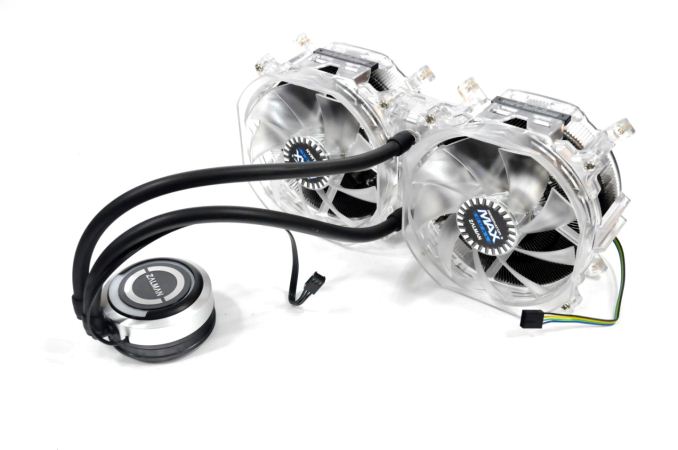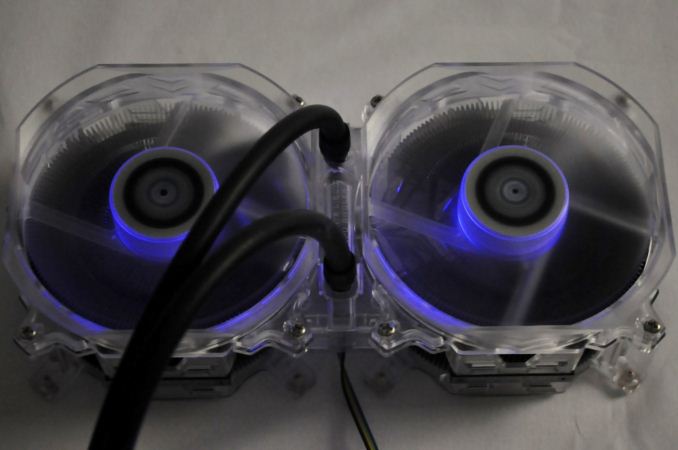Zalman Reserator 3 Max Dual CPU Cooler Review
by E. Fylladitakis on August 19, 2014 6:00 PM ESTConclusion
The Reserator 3 Max Dual is Zalman's trump card in the field of all-in-one liquid coolers and currently the most advanced such cooler that they offer. After they discontinued the Reserator 1 V2, it also is their most expensive liquid cooler, currently retailing for $140 incl. shipping at the time of this review. With the exception of the Enermax kits, which are unavailable in the US and importing them raises their cost dramatically, this makes the Reserator 3 Max Dual the most expensive all-in-one liquid cooler that we have tested to this date, regardless of size and features.
Zalman's Reserator 3 Max Dual certainly has a very long list of positive aspects. To begin with, it sports an impressive appearance that will easily stand out, without being extravagant or overly aggressive. It is very well made, using high quality materials and is free of imperfections. The PWM controlled fans are very handy to have, as their speed can be controlled by the motherboard, essentially emulating a typical CPU cooler and eliminating the need for external speed controllers and unnecessary cable clutter. If quality and appearance are what drives you, the Reserator 3 Max Dual will not be a disappointment.
On the other hand, the Reserator 3 Max Dual is far from flawless. The fancy-looking radiator is bulky and may easily create compatibility problems. Even with the supplied offset installation brackets, the case needs to be wide enough and you might lose a small portion of the radiator's area if the case does not have 140 mm fan openings. Moreover, although it sounds silly and unimportant, the decals on the sides of the radiator are upside down and that will look bad from a windowed side panel of a well-designed system. (Hopefully this is something that Zalman has fixed in their assembly process.) But ultimately, it's the performance of the Reserator 3 Max Dual cooler that confounds us the most.
Every all-in-one cooler that we have ever tested has a thermal resistance that either remains nearly constant or improves slightly as the load increases. Ideally, the thermal resistance of the cooler should be constant, but there are many factors at play in a complex multi-liquid system such as this. However, the thermal resistance of the Reserator 3 Max Dual increases alongside the load, which is inexplicable with what we know about this cooler.
Copper tends to have a thermal conductance that decreases faster than that of aluminum as the temperature rises, but the temperatures that we deal with are low and the change seems rather abrupt, therefore this is not very likely. Although we cannot fully explain why, it seems that the Reserator 3 Max Dual cannot dissipate high quantities of thermal energy quickly enough. This makes it the perfect cooler for the newest generation of processors but, at the same time, a bad idea for anyone who plans to use an energy-hungry CPU (e.g. extreme overclocking).
Our expectations were much higher from a product that is being advertised as the "ultimate CPU cooler". Assuming that the majority of enthusiasts that will buy such a cooling solution will also overclock their systems, we can only recommend the Reserator 3 Max Dual to those that will be using Haswell core processors, as they have very low energy requirements. If you expect the thermal power of your CPU to exceed 120 Watts when stressed, then another product will most likely be both cheaper and more effective.












52 Comments
View All Comments
lorribot - Tuesday, August 19, 2014 - link
You go in to great detail about your test rig and how you test thermal efficiency but completely fail on how you actually test noise, just some " noise measurements are a bit tricky" statement .Actually it is not.
A good test would be the amount of noise produced to cool a given thermal load to say 70C. This would replicate what I would want in the real world, ie how much noise will this thing make cooling my i5/i7 when playing a game or doing massive calculations etc.
Most noise tests seem arbitrary, such as dB with fans a full speed which is worthless information and provides no useful comparison as all fans run a different speed or are subjective observations of the quality of the noise.
Noise generated for a number of given workloads would actually be useful please make it happen.
Hairs_ - Tuesday, August 19, 2014 - link
Silent pc review provide this sort of analysis, in an anaechoic chamber, with stock vs. reference fans. However, their db classification for "silent" is different, and liquid coolers always perform worse than a good air cooler on a "cooling per dB" metric.SPCR's conclusion (which I'd trust above all others) is that liquid coolers are a bad investment as they cost significantly more, produce worse results and are often far too noisy to justify the results. Push enough air and create enough noise, and you can get all sorts of headline grabbing low temperature results...
Gigaplex - Tuesday, August 19, 2014 - link
While I agree that air cooling is generally preferable to liquid cooling from an audible efficiency perspective, at the extreme overclocking end of the scale, air coolers just can't keep up. Another downside to the massive tower air coolers is that there's greater risk of damaging the system during frequent transportation (eg LAN party users). There are trade-offs either way you go.That said, I prefer air cooling as I optimise my systems for noise.
AnnihilatorX - Thursday, August 21, 2014 - link
I disagree. At normal fan speeds liquid coolers tend to lower temperature range and variance, you won't see ultra low temperature, nor you won't see ultra high temperature, and this is due to specific heat capacity of the liquid being higher than air. While overclocked working CPU on air coolers can reach say 70+ deg C, on liquid it would barely reach 40 deg C (speaking from experience) . This is what is important, not low idle temperature.AnnihilatorX - Thursday, August 21, 2014 - link
To clarify the above reply was replying to Hair not GigaplexE.Fyll - Wednesday, August 20, 2014 - link
Actually, it is not as simple as that. Noise measurements are indeed very tricky.Your proposed method however is indeed interesting. However, I would need specific equipment to emulate the PWM thermal control of a motherboard and control the coolers in order to maintain a set temperature. I will be adding that in my long "to buy" list.
I just hope that this will not then start a "comments war" on topics such as "why 150W load and not 160W load", etc etc. :)
Impulses - Tuesday, August 19, 2014 - link
Dunno why we're still obsessed with CPU cooling when must enthusiasts are running GPUs that get far hotter and many are running several of them.We really need some sorta standard bracket/mount that could facilitate mounting these things to GPUs... Anand has featured a couple but they all seemed to have issues, or maybe I didn't pay close enough attention.
SantaAna12 - Tuesday, August 19, 2014 - link
Agree in general about GPUS......but....this is a CPU cooler review that anticipates a new line of enthusiast unlocked chips. Right on time perhaps?abhaxus - Tuesday, August 19, 2014 - link
I have the Kraken G10 mounting a Kuhler 620 to my reference R9 290. I replaced the Kuhler's fan with the stock fan from an H100 and the radiator is mounted in a rigged up location in my case (have it mounted in the 5.25" bays of my Bitfenix Raider). With the fan on low, it is silent and will only hit 90C if I play an extended session of a high GPU usage game (Crysis 3, BF4). With the fan on medium, which is inaudible with music/game audio playing, I never hit over 70C. This is with the card overclocked to 1107/1350 @ +100mv in Afterburner. My VRM temps stay at around 59-65C as well, and I did NOT put VRM sinks on there, just the standard 92mm fan that comes with the G10.Very good purchase overall. Now that the Swiftech H220 is back in America I think I will be purchasing one to properly loop my GPU, however.
flyingpants1 - Wednesday, August 20, 2014 - link
I'm totally in agreement, except for the part where you say "many are running several of them". The market for exotic coolers is pretty tiny, and the amount of people who run multiple GPU setups is vanishingly small.I'd guess over 90% of PC gamers are using single GPUs under 200 watts, GTX 760 or R9 270x. I'd like to see a slew of water coolers released for those cards.
The PC market is really, really, reeeeally slow to adapt. It took like 20 years to make USB cables reversible. They're still using ATX, for god's sake. Mini-ITX is nice, but Apple's new Mac Pro slaughters everything from a design standpoint.